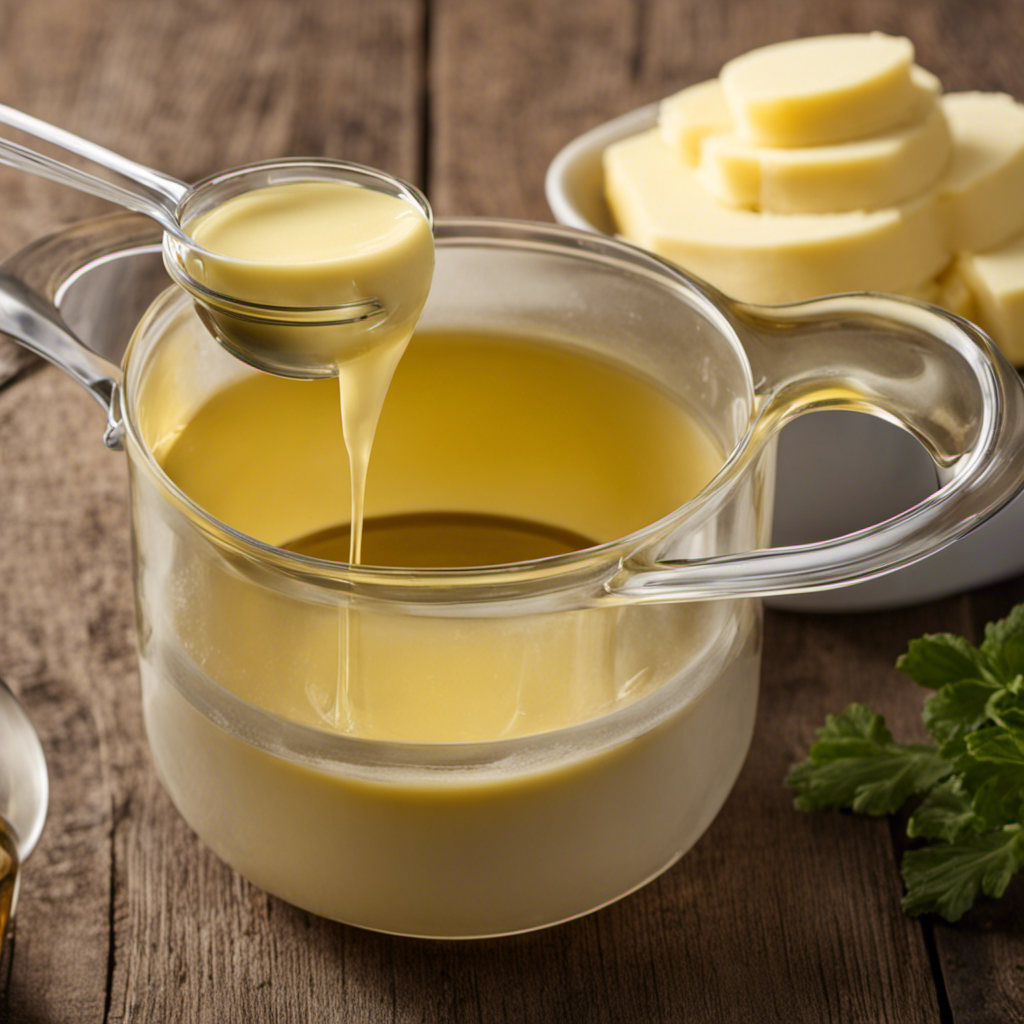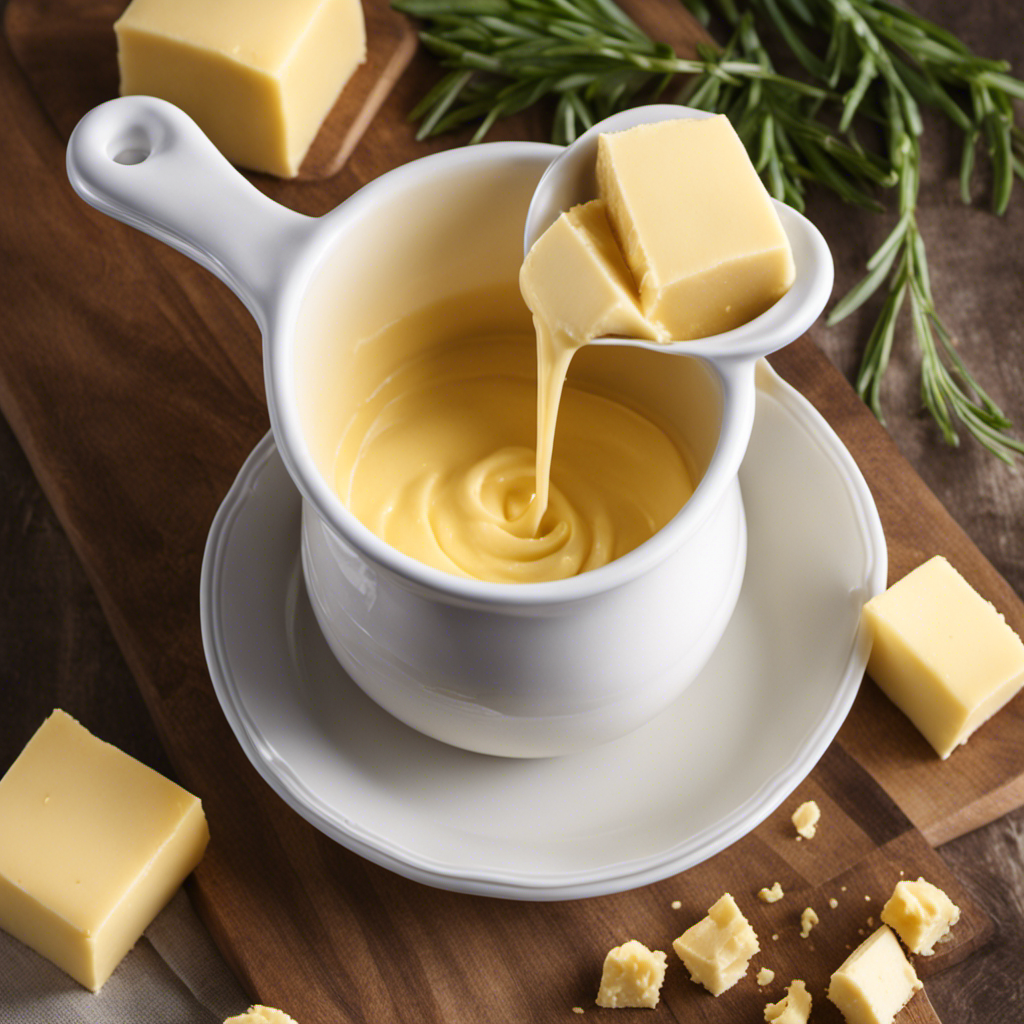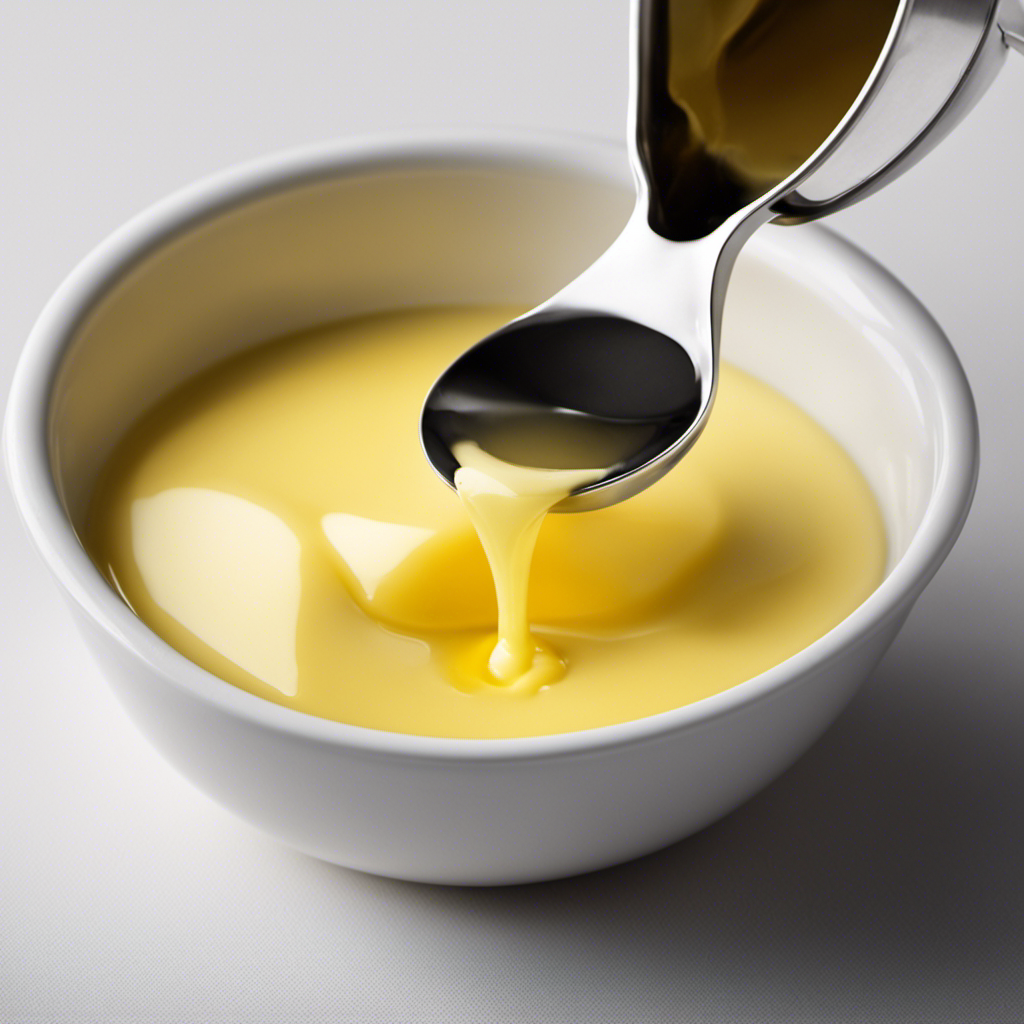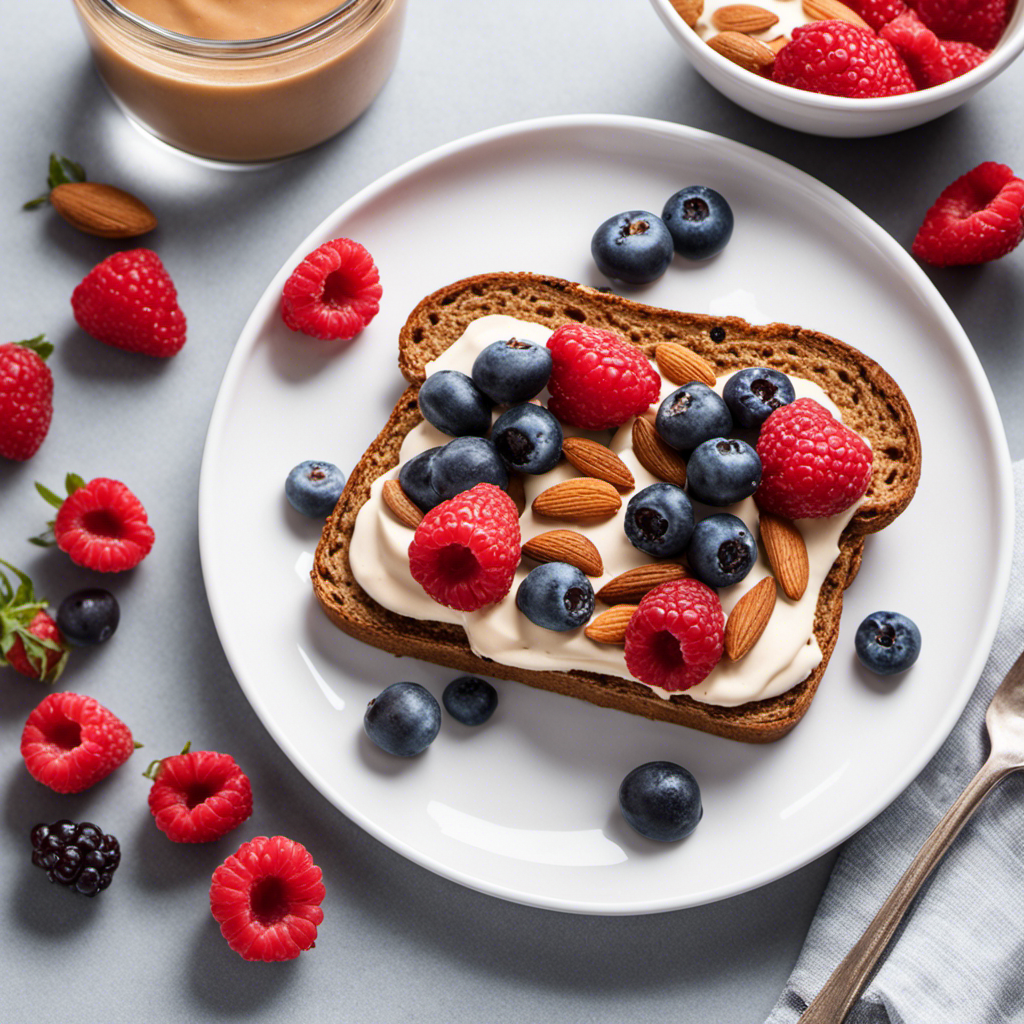Were you aware that swapping oil for butter in your baking endeavors can immensely alter the flavor and texture of the dishes you love? Indeed, it is true! Actually, I found out not too long ago that opting for butter over oil can enhance the richness and taste of your baked creations significantly.
But how much butter should you use when the recipe calls for 1/2 cup of oil? In this article, I’ll share with you the perfect butter to oil conversion ratio and provide you with some helpful tips for achieving delicious results every time.
So, let’s dive in and get baking!
Key Takeaways
- 1 cup of butter is equal to 1/2 cup of oil.
- Butter adds a rich, creamy flavor and texture to recipes.
- Substituting butter for oil can enhance the overall taste of dishes.
- Experimentation is key to finding the perfect balance between butter and oil.
Understanding the Butter to Oil Conversion Ratio
To understand the butter to oil conversion ratio, you’ll need to know how much butter to use for 1/2 cup of oil.
Calculating butter measurements can be a bit tricky, but once you get the hang of it, it becomes second nature.
The general rule of thumb is that 1 cup of butter is equal to 1/2 cup of oil. So, for 1/2 cup of oil, you will need 1/2 cup of butter.
However, it is important to note the advantages of using butter over oil in certain recipes. Butter adds a rich, creamy flavor and texture that can enhance the overall taste of your dish. It also helps with browning and provides a better mouthfeel.
Calculating the Amount of Butter Needed for 1/2 Cup of Oil
When it comes to converting butter to oil in a recipe, knowing the correct ratio is crucial. The butter-to-oil conversion ratio determines how much butter you need to substitute for a specific amount of oil.
It’s important to find the preferred butter substitution to ensure that the taste and texture of your dish remain intact.
Butter-To-Oil Conversion Ratio
You should know that the butter-to-oil conversion ratio is important when determining how much butter to use for 1/2 cup of oil.
When substituting butter for oil in a recipe, it’s crucial to maintain the right balance to achieve the desired texture and flavor. The conversion ratio is generally 1:1, meaning you can use an equal amount of butter as the amount of oil called for in the recipe.
However, keep in mind that butter has a distinct flavor that can enhance the taste of your dish. If you want to preserve the buttery flavor in your cooking, consider using a slightly larger amount of butter in place of the oil. This will lend a rich and creamy taste to your dishes, adding a delicious depth of flavor.
Experimentation is key to finding the perfect balance between butter and oil for your own personal preference.
Preferred Butter Substitution
Using oil as a substitute for butter can lend a different texture and flavor to your dishes.
When it comes to choosing a preferred butter brand, there are several options available in the market that offer a healthier alternative. Brands like Kerrygold and Organic Valley produce grass-fed butter, which is higher in omega-3 fatty acids and vitamins compared to conventional butter. These brands also prioritize animal welfare and sustainable farming practices.
Incorporating butter as a healthier alternative in your recipes not only adds richness and depth but also provides essential nutrients. However, it is important to measure ingredients accurately to ensure the right balance of flavors and textures in your dishes. Proper measurement is key to achieving consistent and delicious results in your cooking and baking endeavors.
The Importance of Measuring Ingredients Accurately
It’s crucial to measure ingredients accurately to ensure the desired outcome of your recipe. Here are four reasons why measuring accuracy is important:
-
Consistency: Precise measurements help you achieve consistent results every time you make a recipe. Whether it’s baking a cake or making a sauce, accurate measurements ensure that the taste, texture, and appearance remain consistent.
-
Balance of Flavors: Accurate measurements allow you to strike the perfect balance of flavors in your dishes. Too much or too little of an ingredient can throw off the taste and ruin the overall dish.
-
Texture and Structure: Baking especially relies heavily on precise measurements. The correct ratios of ingredients like flour, sugar, and leavening agents are necessary for achieving the desired texture and structure in baked goods.
-
Recipe Ratios: Many recipes are formulated with specific ingredient ratios in mind. Accurate measurements ensure that these ratios are maintained, leading to a successful outcome.
Tips for Substituting Butter for Oil in Recipes
When it comes to baking, the choice between using butter or oil can greatly affect the consistency of your recipes.
Butter, with its solid form at room temperature, provides a richer and denser texture, while oil, being in liquid form, creates a lighter and moister outcome.
Additionally, the flavor of butter can add a distinct richness and depth to your dishes, enhancing the overall taste and aroma.
Butter Vs. Oil Consistency
Butter and oil have different consistencies, so choosing between them can alter the texture of your recipe. Here are some key differences to consider when deciding which one to use:
-
Solid vs. Liquid: Butter is solid at room temperature, while oil remains in a liquid state. This difference affects the overall structure of baked goods. Butter creates a more tender and crumbly texture, while oil results in a moister and lighter outcome.
-
Creaminess: Butter adds a rich and creamy flavor to baked goods due to its higher fat content. This can enhance the taste and mouthfeel of your recipe. On the other hand, oil has a neutral flavor, allowing other ingredients to shine.
-
Shelf Life: Butter has a shorter shelf life than oil due to its milk content. It can go rancid if not stored properly. On the contrary, oil has a longer shelf life and can be stored for a more extended period.
-
Melting Point: Butter has a lower melting point than oil. This means that baked goods made with butter will melt and spread more quickly in the oven, resulting in a different texture compared to using oil.
When substituting butter for oil in baked goods, these considerations should be taken into account to ensure the desired texture and taste of the final product.
Butter Flavor in Recipes
The flavor of butter adds richness and depth to various recipes, enhancing the overall taste experience. Many chefs and home cooks prefer using butter for its distinctive taste and texture, despite the ongoing butter vs. margarine debate. Butter has a higher fat content than margarine, contributing to its smooth and creamy consistency. It also contains natural milk solids that give it a unique flavor profile.
When it comes to using butter in recipes, clarified butter can offer additional benefits. Clarified butter is butter that has been melted and separated from its milk solids, resulting in a pure golden liquid. This process removes impurities and increases the butter’s smoke point, making it ideal for high-heat cooking methods like sautéing or frying. The clarified butter retains the rich flavor of butter while being more versatile and resistant to burning.
Adjusting the Recipe for Flavor and Texture When Using Butter Instead of Oil
If you want to adjust the recipe for flavor and texture, you should consider using butter instead of oil. Butter adds a rich and creamy taste to baked goods, enhancing their overall deliciousness. Here are four things to keep in mind when adjusting the butter to oil ratio:
-
Experiment with different ratios: Start by substituting half of the oil with butter and see how it affects the final product. If you prefer a stronger butter flavor, you can increase the amount of butter.
-
Consider the moisture content: Butter contains water, so when using it instead of oil, you may need to decrease the amount of liquid in the recipe slightly to maintain the right consistency.
-
Watch the baking temperature: Butter has a lower smoke point than oil, so keep an eye on the baking temperature. If necessary, reduce the heat slightly to prevent burning.
-
Try different types of butter: There are various types of butter available, such as salted, unsalted, and flavored. Each type can bring a unique taste to your baked goods, so don’t be afraid to experiment and find your favorite.
By adjusting the butter to oil ratio and exploring different types of butter, you can elevate your baked goods to new levels of flavor and texture.
Now, let’s delve into the different types of butter and their effects on baked goods.
Exploring the Different Types of Butter and Their Effects on Baked Goods
To enhance the flavor and texture of your baked goods, try experimenting with various types of butter and see how they affect the end result. When it comes to baking, not all butter is created equal. Different types of butter can vary in fat content, moisture content, and flavor, which can all have an impact on the final product. Here are a few preferred butter brands that are commonly used in baking:
| Brand | Fat Content | Moisture Content |
|---|---|---|
| Brand A | 82% | 16% |
| Brand B | 80% | 18% |
| Brand C | 85% | 14% |
The science behind butter and oil in baking lies in their different properties and how they interact with other ingredients. Butter contains milk solids, which add flavor and moisture, while oil is 100% fat and can result in a lighter texture. Understanding these differences can help you choose the right butter for your desired outcome. Now that we’ve explored the different types of butter, let’s move on to learning how to properly soften butter for baking purposes.
How to Properly Soften Butter for Baking Purposes
When baking, achieving the perfect softness of your butter is crucial. To do this, take the butter out of the fridge and let it sit at room temperature for about 30 minutes. This allows the butter to soften evenly, making it easier to incorporate into your recipes.
However, if you’re short on time, there are a few other techniques you can try. One option is grating the cold butter using a box grater. This increases the surface area and helps it soften faster.
Another technique is microwaving the butter in short intervals. Cut the cold butter into small cubes and microwave it in 5-second intervals, checking and stirring between each one. Be careful not to melt it completely.
You can also try placing the cold butter between parchment paper and flattening it with a rolling pin. This helps to warm it up quickly.
Lastly, using a warm water bath can also soften the butter. Fill a bowl with warm water and place the wrapped butter in it. Let it sit for a few minutes until softened.
Common Mistakes to Avoid When Substituting Butter for Oil
One mistake you should avoid when substituting butter for oil is using too little in your recipe. It is important to remember that butter is not a 1:1 substitution for oil.
Butter contains water and milk solids, which can affect the texture and moisture of your baked goods. To calculate the amount of butter needed, you can use a simple conversion. For every 1 cup of oil, you can substitute 1 cup of butter minus 2 tablespoons. This accounts for the water content in butter.
Another common mistake is not properly melting the butter before adding it to the recipe. It is crucial to melt the butter completely and let it cool slightly before incorporating it. This ensures that the butter is evenly distributed and does not affect the texture of the final product.
Expert Advice: Butter Vs. Oil – Which Is Better for Baking?
For better baking results, you should consider which ingredient – butter or oil – is more suitable. Here are four factors to consider when choosing between butter and oil:
-
Health benefits: Butter contains saturated fats, which can increase cholesterol levels. On the other hand, certain oils, such as olive oil, are rich in monounsaturated fats, which are considered heart-healthy. If you’re looking for a healthier option, oils might be a better choice.
-
Taste comparison: Butter adds richness and a distinct flavor to baked goods. It can create a flakier texture in pie crusts and a tender crumb in cakes. Oil, on the other hand, tends to produce moister baked goods with a lighter texture. Depending on the desired outcome, you can choose between the two based on taste preference.
-
Texture and moisture: Butter has a higher fat content than most oils, which can result in a denser texture. If you prefer a lighter, more tender texture, using oil might be the way to go. Additionally, oil can help retain moisture in baked goods, keeping them fresher for longer.
-
Substitution ratios: When substituting butter for oil or vice versa, it’s important to consider the ratio. Butter is approximately 80% fat, while oil is 100% fat. To substitute oil for butter, use 1 cup of oil for every 1 cup of butter. If you’re substituting butter for oil, use 1 cup of butter for every 1 1/4 cups of oil.
Frequently Asked Questions
Can I Use Margarine Instead of Butter When Substituting for Oil?
Yes, you can use margarine instead of butter when substituting for oil. However, it’s important to note that margarine and butter have different properties and flavors. Consider factors like health benefits and taste preferences.
How Do I Adjust the Cooking Time When Using Butter Instead of Oil?
Adjusting the cooking time when using butter instead of oil can be tricky. The taste difference between the two can affect the outcome. It’s important to experiment and find the right balance for your recipe.
Can I Use Clarified Butter Instead of Regular Butter When Substituting for Oil?
When using ghee instead of oil, clarified butter can affect the texture of baked goods. It adds a rich, buttery flavor and can make the texture more tender and moist.
What Is the Best Type of Butter to Use for Baking Purposes?
Butter is a crucial ingredient in baking. To achieve the best results, I recommend using high-quality brands like Land O’Lakes or Kerrygold. Different types of butter can affect the texture and flavor of your baked goods.
How Does Using Butter Instead of Oil Affect the Taste of the Final Baked Goods?
Using butter instead of oil can greatly enhance the taste of baked goods. It adds a rich and creamy flavor. However, it can also affect the texture and make the final product greasy. To prevent this, use the right amount of butter and follow the recipe carefully.
Conclusion
In conclusion, when it comes to substituting butter for oil in recipes, it’s important to understand the conversion ratio and measure ingredients accurately.
Calculating the amount of butter needed for 1/2 cup of oil can be done by using a 1:1 ratio. However, it’s essential to consider the flavor and texture adjustments that may be needed.
Exploring the different types of butter and properly softening it for baking purposes can also make a difference.
Avoiding common mistakes and seeking expert advice can help create delicious baked goods. So, remember, just like a painter needs the right brush, a baker needs the right butter.










